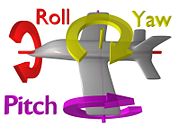Fill in the gaps using the following words from the box
| ,jn rudder hinged dorsal fin h altitude auxiliary stability rear trailing edges |
1. Tail unit provides the necessary ______ of an airplane.
2. An elevator is ______ to the ______ of the tail plane.
3. Elevators control the ______ of the aircraft in flight.
4. _____ can be deflected to the right or to the left.
5. Trimmers are _____ surfaces arranged near the ______ of the movable surfaces.
6. To avoid flutter ______ is used.
Work in pairs. Make up 5 ”False” and 5 “True” statements and tell them your partner. “False” statements should be corrected.
Ask your group mates ten questions concerning the tail unit.
Vocabulary Focus
A) Check if you know the meaning of the following verbs.
To provide, to consist, to intend, to arrange, to hold, to control, to deflect, to reduce, to secure, to fit.
B) Find these words in the text and write out the words collocate with.
C) Think of other nouns they can go with.
d) Give synonyms of the verbs from a).
In the text find the antonyms of the following words and make up your own word combinations with them.
Fixed, to increase, main, to promote, irregular, weak.
Translate from English into Russian.
Оснащать хвостовым оперением, отклонять вверх или вниз, достигается посредством руля высоты, вспомогательная плоскость, шарнирный момент, избегать флаттера, правый борт ЛА, положение самолёта в воздухе.
Use the prepositions in the box to complete the sentences.
| along of at from in of with |
1. Trimmers are used to produce constant control deflections to hold the airplane ____ a certain attitude ____ flight.
2. The dorsal fin is placed ____ the upper side ___ the fuselage body.
3. In order to provide the necessary stability airplanes are fitted ____ a tail unit.
4. Fin is a vertical control surface __ the rear of the fuselage.
5. Trimmers are adjustable ___ the cockpit.
Writing
Match the beginnings and the endings of the sentences.
1. In order to provide the necessary a) along the upper side of the aft
stability … portion of the fuselage body.
2. The dynamic balancing is one b) he moves the rudder to the right.
of the precautions taken….
3. Directional control of the airplane c) to produce constant control
is achieved …. deflections.
4. The structure of the tail unit d) airplanes are fitted with a tail unit.
consists of …
5. A movable control surface e) this is done by means of the
called an elevator is … elevator.
6. When the pilot needs to change f) to avoid flutter, a violent vibration
his flight direction to the right… of a wing or control surface.
7. Dorsal fin is placed … g) by means of the rudder, which is
a movable vertical surface.
8. Balance areas reduce the hinge h) to right or left or retained in the neutral
moment ….. position in line with the fin.
9. Trimmers represent small adjustable i) hinged to the rear of the stabilizer.
areas arranged …
10. If the pilot needs to cause the nose j) needed to deflect surface.
to rise or fall ….
11. Trimmers are used …. k) longitudinal and transverse structural
elements called spars and ribs.
12. Rudder is hinged to the rear of l) near the trailing edges of the movable
the fin and can be moved … surfaces.
Translate in a written form matching with the picture.
Three Axes of an Airplane

An aircraft is free rotate around three axes which are perpendicular to each other and intersect at the plane’s center of gravity (CG). To control the position and direction a pilot must be able to control rotation about each of them.
Vertical axis. The vertical axis passes through the plane from top to bottom. Rotation about this axis is called yaw. Yaw changes the direction the aircraft’s nose to the left or right. By using the rudder the pilot can cause the airplane to yaw to either side.
Longitudinal axis. The longitudinal axis passes through the plane from nose to tail. Rotation about this axis is called bank or roll. Bank changes the orientation of the aircraft’s wing with respect to the downward force of gravity. The pilot changes bank angle by increasing the lift on one wing and decreasing it on the other. This differential lift causes bank rotation around the longitudinal axis. The ailerons are the primary control of bank.
Lateral axis. The lateral axis passes through the plane from wingtip to wingtip. Rotation about this axis is called pitch. The nose and the tail surfaces of the airplane can move up and down around the lateral axis. The pilot can use the elevators to raise or lower the nose of the airplane.
Speaking
